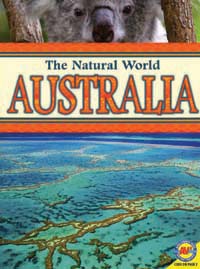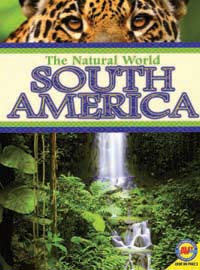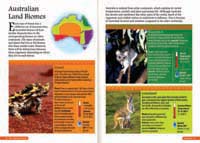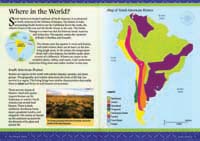| ________________
CM . . .
. Volume XXI Number 26. . . .March 13, 2015

 |
Australia. (The Natural World).
Jenna Myers.
New York, NY: AV˛ by Weigl (Distributed in Canada by Saunders Book Company), 2015.
32 pp., pbk., hc., single user eBook & multi user eBook, $13.95 (pbk.), $24.99 (hc.).
ISBN 978-1-4896-0947-2 (pbk.), ISBN 978-1-4896-0946-5 (hc.), ISBN 978-1-4896-0948-9 (single user eBook), ISBN 978-1-4896-0949-6 (multi user eBook).
Subject Headings:
Natural history-Australia-Juvenile literature.
Australia-Environmental conditions-Juvenile literature.
Grades 4-8 / Ages 9-13.
Review by Sherry Faller.
**** /4
|
| |
|
 |
South America. (The Natural World).
Lyn Sorota.
New York, NY: AV˛ by Weigl (Distributed in Canada by Saunders Book Company), 2015.
32 pp., pbk., hc., single user eBook & multi user eBook, $13.95 (pbk.), $24.99 (hc.).
ISBN 978-1-4896-0959-5 (pbk.), ISBN 978-1-4896-0958-8 (hc.), ISBN 978-1-4896-0960-1 (single user eBook), ISBN 978-1-4896-0961-8 (multi user eBook).
Subject Headings:
Natural history-South America-Juvenile literature.
Ecology-South America-Juvenile literature.
South America-Environmental conditions-Juvenile literature.
Grades 4-8 / Ages 9-13.
Review by Sherry Faller.
**** /4
|
| |
|

excerpt:
Australia is unusual for its endemic species. Endemic species are plants and animals that are found only in a particular place or region. One reason people visit Australia is to see plants and animals that cannot be found anywhere else in the world. More than 80% of Australia’s plants, mammals, reptiles, and frogs are endemic. Some of Australia’s best known endemic animals are the kangaroo, the koala, the platypus, the echidna, and the wombat. (From Australia.)
“The Natural World” series includes a book about each continent and explains the biomes found there. Within each biome, the animals, plants, terrain and climate, both temperature ranges and rainfall are listed. Animals and plants that live within each biome are mentioned, some with supporting photographs. Not only are the land biomes detailed, but the aquatic ecosystems, both freshwater and saltwater, are also explained featuring excellent photos of animals found in those areas. Pages explaining how the ecosystems balance or how they have been thrown off balance make for interesting reading. Interaction maps of how the ecosystem is interconnected serve as a springboard for readers to create their own web by trying one of the on-line activities. Human impact and details on how to conserve nature are important features of this series and could initiate an ecological project.
 Australia is a well-researched book. The unique animal and plant-life are featured for each biome on the continent. Young readers will be especially interested in the aquatic life, such as the whale shark, reef stonefish with its unusual camouflage and poisonous dorsal fin, as well as the box jellyfish and green sea turtle, so named for its green fat. Australia is a well-researched book. The unique animal and plant-life are featured for each biome on the continent. Young readers will be especially interested in the aquatic life, such as the whale shark, reef stonefish with its unusual camouflage and poisonous dorsal fin, as well as the box jellyfish and green sea turtle, so named for its green fat.
South America includes the unique animals found on the Galapagos Islands, like the tortoise than can weigh up to 500 pounds and can live for more than 100 years. This continent has the largest rainforest in the world that can be seen by astronauts in space. Chaparral, desert, forest, tundra, mountains and grassland cover the rest of the continent. Some exciting animals featured are the Blue Morpho butterfly, green anaconda, poison dart frog, and the marine iguana. Most significant is the human impact on the Amazon rainforest, with 20% of it lost to slash and burn land-clearing techniques over the last 40 years. Readers can learn how this destruction has affected wildlife and the ecosystem.
 Beautiful color photographs adorn the pages, and sidebars titled “Just the Facts” provide interesting trivia about the topic. For example, “Australia has more than 700 species of grass. 55% of a eucalyptus leaf is made up of water.” A quiz, glossary and index are found at the back of the books, as well as instructions for using the AV˛ website.
Beautiful color photographs adorn the pages, and sidebars titled “Just the Facts” provide interesting trivia about the topic. For example, “Australia has more than 700 species of grass. 55% of a eucalyptus leaf is made up of water.” A quiz, glossary and index are found at the back of the books, as well as instructions for using the AV˛ website.
Going to www.av2books.com and entering the book code at the front of the book opens up further research possibilities. Each double page spread offers either a video, interactive worksheet, or links to other information found on sites like World Book on-line and the World Wildlife Federation.
This excellent series is essential for student research and should be included in any school library or classroom library.
Highly Recommended.
Sherry Faller is a retired teacher-librarian in Winnipeg, MB.

To comment
on this title or this review, send mail to cm@umanitoba.ca.
Copyright © the Manitoba Library Association. Reproduction for personal
use is permitted only if this copyright notice is maintained. Any
other reproduction is prohibited without permission.
Next Review | Table of Contents For This Issue - March 13, 2015
CM Home | Back Issues
| Search
| CM Archive
| Profiles Archive
|


 Australia is a well-researched book. The unique animal and plant-life are featured for each biome on the continent. Young readers will be especially interested in the aquatic life, such as the whale shark, reef stonefish with its unusual camouflage and poisonous dorsal fin, as well as the box jellyfish and green sea turtle, so named for its green fat.
Australia is a well-researched book. The unique animal and plant-life are featured for each biome on the continent. Young readers will be especially interested in the aquatic life, such as the whale shark, reef stonefish with its unusual camouflage and poisonous dorsal fin, as well as the box jellyfish and green sea turtle, so named for its green fat. Beautiful color photographs adorn the pages, and sidebars titled “Just the Facts” provide interesting trivia about the topic. For example, “Australia has more than 700 species of grass. 55% of a eucalyptus leaf is made up of water.” A quiz, glossary and index are found at the back of the books, as well as instructions for using the AV˛ website.
Beautiful color photographs adorn the pages, and sidebars titled “Just the Facts” provide interesting trivia about the topic. For example, “Australia has more than 700 species of grass. 55% of a eucalyptus leaf is made up of water.” A quiz, glossary and index are found at the back of the books, as well as instructions for using the AV˛ website.